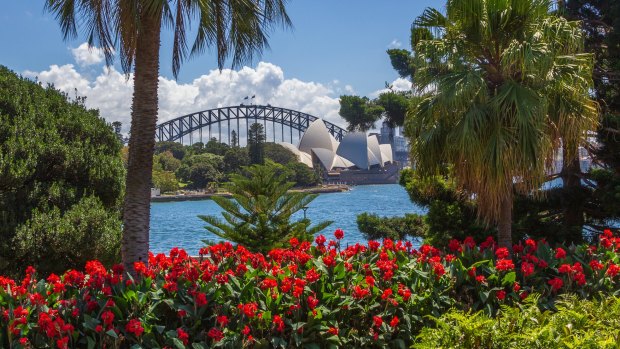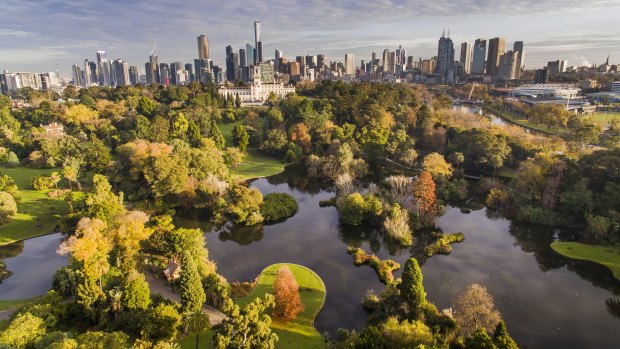This was published 1 year ago
Cities aren't liveable without public parks - the lungs and social heart
By Lee Tulloch

Sydney's Royal Botanic Garden is surely the most picturesquely located public garden in the world.Credit: iStock
On one of the first sunny Sundays this spring I followed the crowds and meandered along Sydney's waterfront and into the Royal Botanic Garden, surely the most picturesquely located public garden in the world, with its dress circle views of the Opera House and Harbour Bridge.
Sydney was at its sparkling best and the garden beds were crowded with bright spring flowers. People gathered there in small groups, laying out picnic blankets on the lawns, filling the outdoor tables at the cafe, wandering through the groves of palms and ferns. It felt very festive as people rediscovered the joy of the gentle Sunday stroll after a few months huddling indoors out of the rain.
Public gardens and parks are not only the lungs of a city, they are also the city's social hearts, certainly if you think of the great metropolitan parks such as New York's Central Park, which is not just a place to breathe in fresher air, jog, ice-skate, picnic or protest, it's where people, isolated in small apartments, come out to feel as if they're part of the human race.

Melbourne's Royal Botanic Gardens.Credit: Visit Victoria
The Italians have their passeggiata, the evening stroll, that is as much about being out in the world and seeing other people as it about exercise for good health.
The past couple of years have shown us how important parks are for our mental wellbeing. For a while during the lockdowns, they were the few permitted public places where we could see other humans outside the home. I remember the first weekend when we were free to picnic in the park in (suitably distanced) groups. No one cared that there were people and dogs everywhere or that it was hard to find your own spot on the lawns – it was the community we missed.
I grew up in a suburb of Melbourne that had no large public park, but we were lucky to have big backyards. We valued the privacy that backyards brought, our own special domains, although there was the occasional family trip to the Fairy Tree in the Fitzroy Gardens or to pluck cicada skins off the trees in the Treasury Gardens.
Later on, I lived across the road from Melbourne's Botanic Gardens, another of the world's great public gardens, and within walking distance from the city centre. I attach strong memories to this place - the stone pavilions where we held birthday parties, the swans we fed on the lake, my daughter climbing trees.
But it wasn't until I lived in Paris, a short walk from the Luxembourg Gardens on the Left Bank, that I began to appreciate the pleasures of communal leisure. The 25 hectares of parkland, which date back to 1612, are quite glorious, with manicured lawns, abundant flower beds, tennis courts, a forest and an orchard. For children, there's the ancient Guignol puppet theatre, pony rides and toy wooden boats to sail on the pond.
Lounging on a wrought-iron chair under the canopy of the chestnut trees and watching the parade of well-dressed Parisians, accompanied by a soundtrack of squealing kids, is one of the great pleasures of Paris.
From Copenhagen's Tivoli Gardens to the Zen beauty of the Ryoan-ji garden of raked pebbles and stones in Kyoto, there's hardly a world city that doesn't have a public park worth seeking out.
Sometimes it might seem that dallying in a park is a waste of precious time when you're a visitor but it's one of the nicest ways to experience the quotidian life of a place and be part of it for a few moments or hours.
Municipal governments know the magic of public parks and their importance in making the environs greener and more liveable, and we've seen some novel solutions to creating public space in recent years, such as the High Line development on the old railway tracks on New York's west side. There's now a commitment from the NSW Government to turn part of Sydney's ugly Cahill Expressway into a similar green promenade. Won't that be splendid?
We need to give thanks to the city planners, garden designers and botanists who historically had the vision to annex swathes of their cities for public use. The battle with developers over public spaces continues, as with the disappearing public foreshore at Sydney's Barangaroo.
Can you imagine Central Park crammed with skyscrapers or Sydney's Botanic Garden as the private playground of people who were allowed to build harbourfront mansions on its slopes?
It doesn't bear thinking about.
lee.tulloch@traveller.com.au
Sign up for the Traveller newsletter
The latest travel news, tips and inspiration delivered to your inbox. Sign up now.